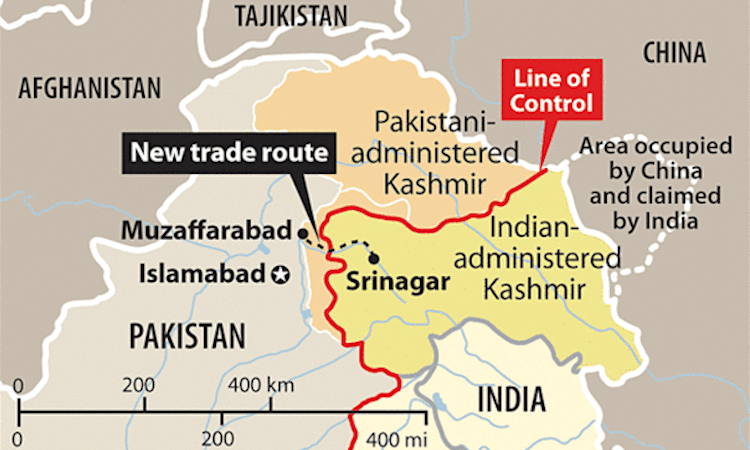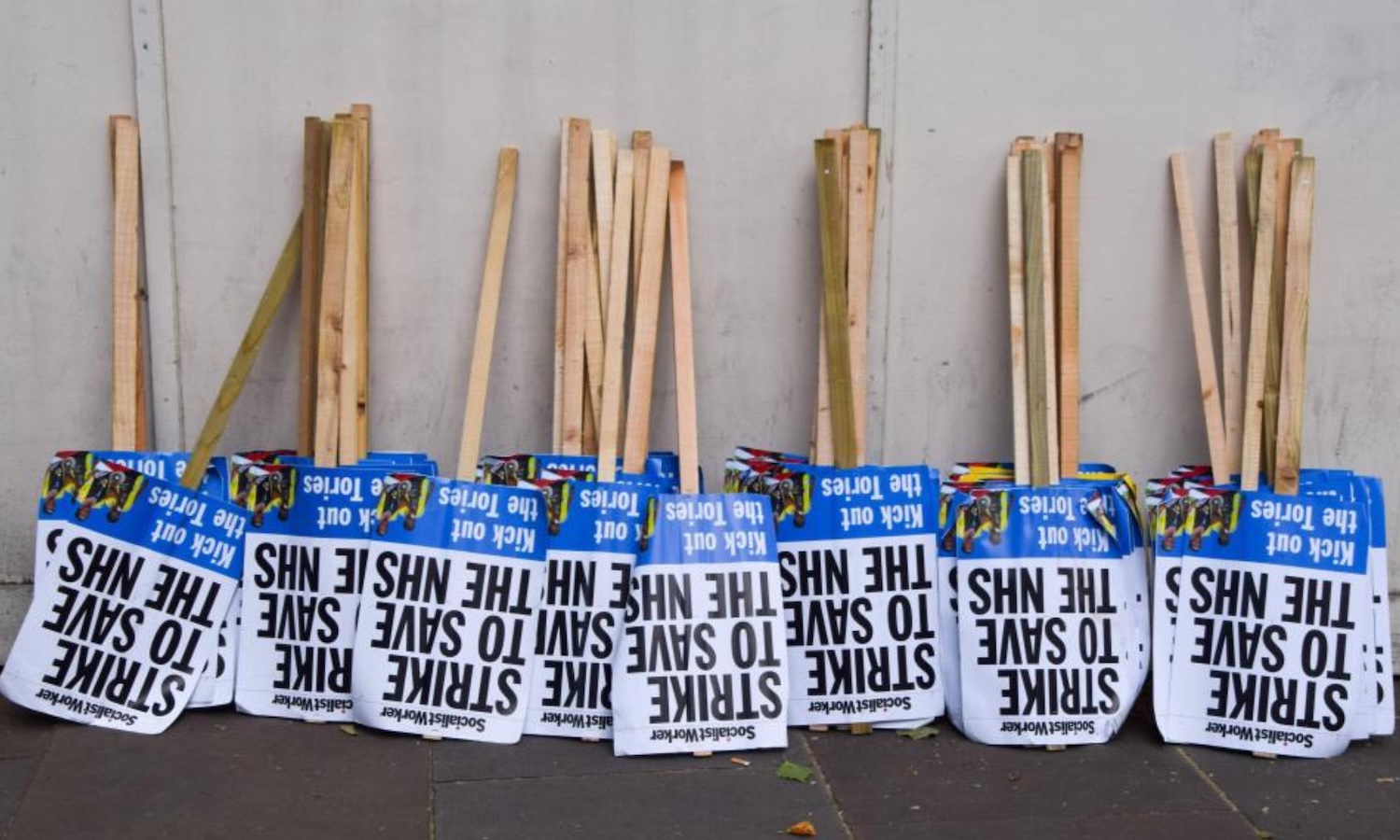When Indian parliamentary elections first brought the currently ruling BJP government to power, it was because of a belief that the party’s leader, Narendra Modi, was a good manager of the economy and would thus bring prosperity to India.
In this, however, he has signally failed, adopting policies such as the sudden demonetarisation of 500 and 1,000 rupee notes, which caused economic chaos particularly harmful to poorer people, while economic growth has been falling steadily for the past six years.
To shore up his waning popularity, therefore, prime minister Modi has increasingly been appealing to religious chauvinism among India’s 80 percent majority hindu population by endorsing the aim of making India a hindu rashtra – a hindu nation. It was this that enabled his government to be re-elected last year despite its dismal economic performance.
And it is continuing dismal economic performance that is egging Modi on to further fan the flames of communalism, particularly anti-muslim communalism, muslims constituting 14 percent of India’s population. This means that they number over 200 million, slightly more even than in Pakistan.
“Activists say it’s just the latest move in the BJP’s broader agenda of creating a ‘hindu nation’, with the government’s recent revocation of the special status of the muslim-majority state of Jammu and Kashmir and plan to build a hindu temple at the site of a mosque demolished by a hindu nationalist mob in 1992.” (‘This is not just a muslim fight.’ Inside the anti-Citizenship Act protests rocking India, Time magazine, 16 December 2019)
The Citizenship Amendment Act
This is the context surrounding the mass demonstrations that have been taking place against the Citizenship Amendment Act passed by the Modi government on 12 December 2019.
According to this legislation, India will be prepared to fast track the granting of citizenship to refugees fleeing from Pakistan, Bangla Desh and Afghanistan provided they are hindus, sikhs, buddhists, jain, parsi or christians – ie, they are not muslims (jews, agnostics and atheists are also excluded but this is only incidental).
This act flies in the face not only of India’s secular constitution, which prohibits unequal treatment on the basis of religious affiliation, but also of international law on refugees, which requires asylum be given not on the basis of religious affiliation but on the basis of whether the claimant has suffered or is likely to suffer persecution.
If non-muslims can face persecution in Pakistan, for example, so can members of islamic sects such as the Ahmadis and the shias, yet India would refuse to even consider their cases.
Citizen registration
What adds gravity to the matter, however, is that this citizenship law is being introduced in tandem with a process of citizen registration that has already been implemented in Assam, a state in the far north-east of India, where 34 percent of the population is muslim as against 61 percent hindus.
Assam has 27 districts, out of which nine have a majority muslim population. This experiment in citizen registration has been nothing short of a disaster. Nearly 2 million people out of a total population of 33 million have been left off the register, some of them members of the same family as persons who had been registered.
Theoretically, the purpose of the register was to exclude people who had immigrated illegally from Bangla Desh after 1971 (and their descendants, even when born in India), but it was up to the applicant for registration to prove they had been resident since before that time, and many of them simply did not have any documentation.
Munoth, a lawyer, told CNN most exclusions from the National Register of Citizens (NRC) happened because people simply didn’t have the documentation.
“It’s just unthinkable. If I was asked to prove my citizenship, I would be at pains to find a document that says my ancestors came to India before 1947, and this is me with my class and caste privilege and education. You can only imagine what a daily wage labourer would go through,” she said. (1.9 million excluded from Indian citizenship list in Assam state by Helen Regan and Manveena Suri, 31 August 2019)
“If the government were to hold the national register today, [many muslims] would stand to become stateless. Forget the complicated documents they will require. They do not even have basics such as birth certificates, and their situation is replicated across the country.
“For poor Indians, floods, fires, riots and the constant movement from one state to another in search of work … mean papers get lost. Shiny filing cabinets filled with neatly classified folders do not feature in their lives.
“A few … have voter cards and the official ID card known as aadhaar. But if the register recently conducted in the northeastern state of Assam is anything to go by, these papers will count for nothing. There, claimants were required to provide documents proving their links to ancestors going back decades. Some 1.9 million were left off the list.
“They are now effectively illegal immigrants, with nowhere to go. Some 3,000 will be housed in a detention centre currently being built, the first of ten planned in the state …
“‘They don’t have anything we can begin with,’ … ‘They have nothing. For the most basic official document, you need proof of residence, you need a utility bill in your name. No one in a slum has any of these.’
“[One lady] said: ‘When floods in Bihar washed away my home and cattle in 2008, I tried to stay alive and save my children, not my papers.’ Later she shows the pitiful hut she calls home, covered with stitched together hessian sacks next to an open drain …
“Nadia Hussain, 43, who also fled to Delhi after floods in Bihar, tried to get some official documents but found the first obstacle insuperable. ‘My landlord refused to give me proof of residence because he doesn’t want to pay tax on his rental income,’ she said …
“Even if muslims have some official papers, they are bound to contain discrepancies and misspellings in names and addresses.
“It is a national idiosyncrasy to be cavalier about spellings and accuracy. The common name Chatterjee, for example, can also be spelt Chatterjea, Chatarji, Chatterji or Chaterjee. The name Mohammed can be spelt umpteen ways. Ages can be off by a few years. No one is bothered. Now this carelessness could mean the destruction of the rights of hundreds of millions.” (India’s citizenship test unleashes muslim despair and fury by Amrit Dhillon, The Times, 20 December 2019)
No papers to prove citizenship, even if actual detention is avoided (which can’t be guaranteed) means no work and no money on which to live.
Although those left off the register have a right of appeal, for poor people this is no right at all as they would not have the means to pay for professional assistance, meaning that their appeals would be unlikely to succeed. Nor can many even travel to courts that can be 50km away.
The citizen registration exercise in Assam clearly failed to identify illegal immigrants from Bangla Desh, since half of those left off the register were hindus and not muslims at all. An earlier draft of the register was particularly embarrassing:
“The first draft list drawn up by the National Register of Citizens put almost 4 million people in Assam at risk of statelessness.
“Somewhat undermining the BJP’s anti-muslim agenda, the list embarrassingly included hindu political leaders and government employees, including one person whose job it was to compile the NRC. While a revised list brought the numbers down to just below 2 million people, to the BJP’s dismay this still included a substantial number of hindus.” (Narendra Modi’s anti-muslim bill risks carnage in Assam by Champa Patel, The Sunday Times, 15 December 2019)
In these circumstances, Modi came up with the Citizenship Amendment Act wheeze, which would enable the authorities to grant citizenship to non-muslims left off the register.
Resistance
The Citizenship Amendment Act has given rise to massive demonstrations all over India.
In Assam, the population is furious because it is seen as giving the green light to mass immigration of Bengali hindus from Bangla Desh, whom the Assamese see as a threat because of the general lack of resources in their extremely poor state.
Elsewhere, there is outrage at the assault on India’s secular constitution and the kick in the teeth delivered to poor people, overwhelmingly, though not exclusively, muslim.
Most of the people adversely affected by the act have never known any other country but India. Most of them were born in India, often several decades ago, some of them even in pre-partition India, yet are suddenly to be declared not to be Indian at all. There is no wonder that millions of people are up in arms.
Massive demonstrations have been taking place in 56 cities in 24 states all over India on a daily basis since the act became law on 12 December.
These have been met with savage repression by the police, using tear gas and brute force against defenceless protesters, and by emergency laws banning gatherings of more than five people with the excuse that some violent acts have been committed by those protesting.
Even the internet has been closed down for several hours. What is not mentioned is the provocation on the part of the government forces that has given rise to counter-violence.
According to Time magazine: “It was at two historically muslim universities, Aligharh Muslim university and Jamia Millia Islamia university, where the police response was most violent – firing tear gas and beating students …
“Abdulla, who was beaten by police in a video that went viral, is a student at Jamia Millia Islamia. Ladeeda Farzana, a muslim from the state of Kerala and fellow student, was one of several women who formed a human shield around him … Farzana says she was struck on her back when shielding Abdulla. It still hurts. ‘I feel pain but it’s fine,’ she says.
“Delhi police maintain that they used ‘maximum restraint, minimum force’ while responding to protests at Jamia.
“But Mohammad Mustafa, a student there, said … he was studying in the library when police beat him until he fell unconscious. ‘I don’t have anything to do with the protest. I’m just here to study,’ he recalls telling them. Mustafa says both his arms were fractured and that police deliberately broke his laptop …
“During the crackdown at Aligarh university, police allegedly shouted ‘Jai Shree Ram’ – a hindu slogan meaning ‘Victory for Ram’ – while beating students. The phrase has frequently been used by the BJP and its supporters.
“Mohammad Minhajuddin, another student at Jamia, said he was studying in the university’s central library when he was beaten so badly by the police that he was left blinded in one eye and may soon lose visibility in the other … He tried to protect himself by putting his hand to his face; two of his fingers were fractured.
“Several women were also attacked during the protests. Saima Anjum, a second-year law student at Jamia, tells Time that she and many other students on campus were beaten by police.
“She recalls seeking shelter in the university’s reading room from the tense protests with other students. They bolted the doors and sat under tables before officers in blue uniforms burst through the door, she says. ‘They started beating all of us,’ she says. ‘Five to six policemen were beating one single student. They dragged me also.’
“One officer started hitting her when another interjected, saying: ‘Leave it, leave it, she’s a girl, let her go.’ She watched as one of her friends was beaten brutally before he ran away and sheltered himself in a mosque …
“A lawyer who appeared to be representing some Jamia students detained after the protests alleged in a statement that police sexually assaulted students at Jamia, switching off the lights so as not to be caught on CCTV.
“Police also stormed the university’s library, firing tear gas at students barricaded inside. Some students hid in the women’s bathrooms, and police entered, began beating people and broke the mirrors, students said. ‘Students were lying bleeding inside the washroom,’ one student who was present told Time.
“No deaths have been confirmed at the protests at universities around the country. But many students are missing. More than a dozen students from Aligarh Muslim university are still unaccounted for after police cracked down on protests there, leaving more than 100 reportedly injured.” (Op cit)
It is not only muslims, however, who are resisting the act. Virtually all major Indian political parties other than the BJP and Shiv Sena are supporting the demonstrators.
“Almost the entire top left leaders, including Sitaram Yechury [general secretary of the Communist Party of India (Marxist), D Raja [general secretary of the Communist Party of India] and Prakash Karat [previous general secretary of the Communist Party of India (Marxist)], were detained here along with the Delhi Congress leaders Ajay Maken and Sandeep Dikshit during the left-sponsored anti-CCA protest near Mandi House and Jantar Mantar area that saw an impressive turnout.” (All-India protests against Citizenship Act, Economic Times, 20 December 2019)
Prakash Karat’s wife Brinda was also detained.
Many well-known Bollywood actors have joined the protests as have some distinguished academics. “In a statement released by her publisher, Arundhati Roy, one of India’s most famous writers, compared the Citizenship Amendment Act and NRC to the Nazis’ 1935 Nuremberg laws, which blocked jews from German citizenship.” (Time magazine, op cit)
Non-muslim students have formed human chains around their muslim fellow students in order to protect them from police violence.
Moreover, several state governments have pledged not to proceed with the registration exercise at all. For instance:
“In West Bengal, Mamata Banerjee, the chief minister, has led several huge marches against the citizenship law and register. She has said that they will be introduced ‘over my dead body’.
“Ms Banerjee said that she wanted to know how many detention camps Mr Shah would have to build to house alleged non-Indians.” (Opposition to India’s citizenship law has become a national crisis by Amrit Dhillon, The Times, 20 December 2019)
For the moment it is not known what will be the fate of the millions of people adversely affected by the Citizenship Amendment Act, other than that they will become stateless.
Are they all to be rounded up and deported? If so would the destination countries accept them? What about their property rights? Are they to lose their right to residence in India, and/or their right to work?
That this has not been spelt out suggests that the Modi government is waiting to see how much it is likely to be able to get away with in its vendetta against non-hindus. The reaction of the masses of people in India, however, does give hope that dreams of a theocratic hindu state are on the way to being comprehensively smashed.













